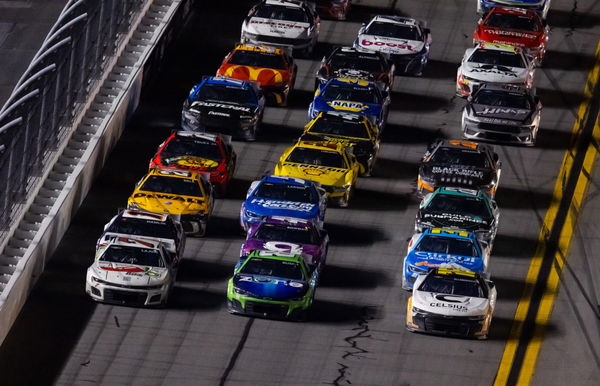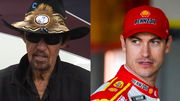
via Imago
NASCAR

via Imago
NASCAR
As the sport continually evolves to enhance competition, changes in fan engagement are constant in NASCAR. Over the decades, NASCAR has implemented numerous adjustments, ranging from safety innovations to overhauling the championship structure. These changes aim to keep the sport dynamic while addressing drivers, teams, and fans’ feedback.
One such revolutionary moment came in 2011, marking a pivotal chapter in NASCAR’s legacy. The introduction of a revamped championship format left fans celebrating, bringing clarity and excitement to the season. Today, as NASCAR completes 14 years of that iconic season, let’s recall the historic changes of the 2011 season.
ADVERTISEMENT
Article continues below this ad
What were the NASCAR’s 2011 changes?
Some decisions have sparked debate, with diehard enthusiasts often wary of tampering with tradition. However, history shows that change has propelled NASCAR forward. Whether it’s the introduction of the Chase system or revising qualifying rules, these innovations aim to simplify the sport and make it more exciting for viewers.
The 2011 season was a game-changer for NASCAR, marking the first major overhaul of the points system since 1975. Simplicity was the driving force behind this decision. NASCAR replaced the traditional system, which confused even the most loyal fans, with a straightforward structure. The system directly tied points to finishing positions, with first place earning 43 points and last place receiving only one.
Bonus points added an extra incentive for winning, leading laps, or dominating the race. This change created a stronger emphasis on victory. Winners could collect up to 48 points, significantly more than the previous system’s bonus incentives. Second place would earn 44 points, a smaller gap that further motivated drivers to aim for wins rather than settling for consistency.
January 26, 2011: NASCAR announced a new points system where positions were separated by one point, and winners received a maximum of 48 points
And the 10 race playoffs would consist of the top 10 in points, plus the two drivers with the most wins outside of the top 10. pic.twitter.com/66tRO0j6qu
— nascarman (@nascarman_rr) January 26, 2025
Beyond points and playoffs, NASCAR addressed long-standing issues with fairness in qualifying. NASCAR prioritized practice speeds to determine the starting lineup, thus ensuring faster drivers a competitive edge even with disrupted weather sessions. This move encouraged fans to tune in for practice and qualifying, knowing that Friday sessions now carried higher stakes.
What’s your perspective on:
Did NASCAR's 2011 points overhaul save the sport, or did it stray too far from tradition?
Have an interesting take?
Notably, NASCAR also announced some improvements for the safety issues. The introduction of a closed-loop fuel system eliminated the need for a catch-can man, reducing crew members over the wall and enhancing safety. Additionally, new bodywork changes brought the cars closer to resembling their manufacturer models, pleasing both sponsors and fans.
With these changes, NASCAR almost overhauled the structure of the sport. These changes initially attracted a mixed reaction from fans. However, over the years, these changes proved crucial for NASCAR to engage and attract younger audiences. It also helped to keep the season engaging.
Trending
A seismic rule change rocks the 2025 season
As NASCAR gears up for the 2025 season, new rule updates signal another step forward. Competition officials recently announced a series of updates aimed at refining race-day operations, enhancing fairness, and elevating fan engagement. One of the most significant changes is the introduction of the Open Exemption Provisional (OEP) rule.
ADVERTISEMENT
Article continues below this ad
This measure expands the starting grid to a maximum of 41 cars for select races. Notably, eligible drivers will compete for race wins and trophies but will not earn championship points or playoff eligibility. The first driver to get the benefit of the new rule is four-time Indy 500 champion Helio Castroneves. He has been guaranteed a spot in the season-opening Daytona 500.
Another significant update is the adjustment to the Damaged Vehicle Policy (DVP). Starting in 2025, damaged cars towed to the garage will be allowed to return to the race after repairs. While the seven-minute repair limit on pit road remains unchanged (eight minutes for Atlanta races), teams will no longer face a timer in the garage. This change ensures that teams can focus on making thorough repairs without the added pressure of a countdown.
NASCAR also clarified its stance on playoff waivers. Drivers granted waivers due to suspensions or voluntary absences will forfeit all accumulated playoff points. However, waivers issued for medical reasons, family emergencies, or age restrictions will not impact a driver’s playoff standing. Notably, this was the same rule under which NASCAR allowed Kyle Larson to miss the Coke 600 race.
ADVERTISEMENT
Article continues below this ad
As NASCAR gears up for the 2025 season, these updates continue the tradition of blending innovation with competition. From preserving fairness to enhancing fan engagement, the upcoming changes reflect NASCAR’s unwavering commitment to pushing the sport forward.
ADVERTISEMENT
ADVERTISEMENT
ADVERTISEMENT
ADVERTISEMENT







Did NASCAR's 2011 points overhaul save the sport, or did it stray too far from tradition?